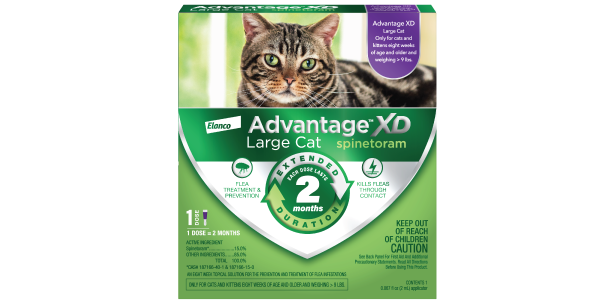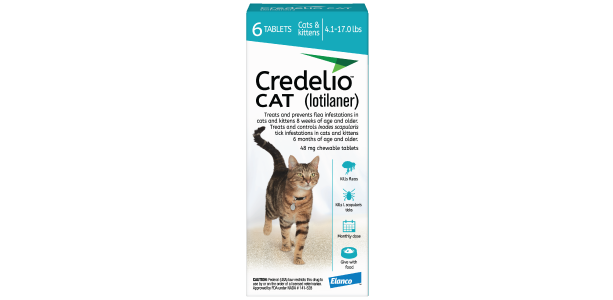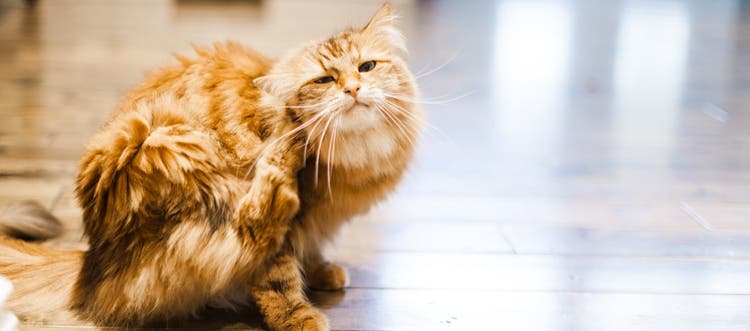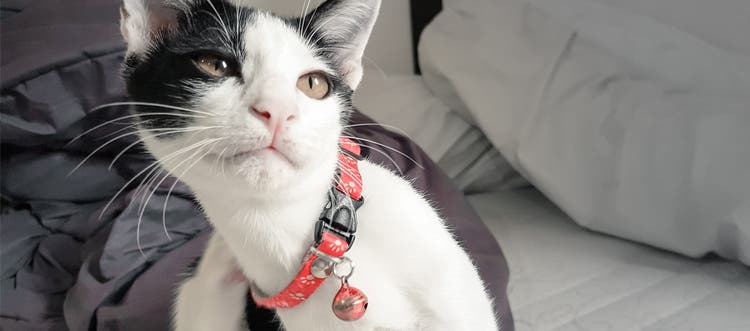Fleas do more than just bite your cat — they can transmit diseases, cause health issues and irritate skin. Keep reading to learn more about the associated risks of flea bites.
Even if your cat spends most of their time indoors, fleas and flea eggs can still make their way into your cat’s everyday environment by hitching a ride on other pets or humans. Fleas can hide behind baseboards, in your pet’s bedding or blankets, in the cracks in your flooring, in carpeting and in other places throughout your home and backyard. It’s no small wonder, then, that flea infestations are common in cats.
4 Diseases Carried by Fleas That Could Make Your Cat Sick
While a flea infestation is a big problem on its own, diseases carried by fleas can also introduce your cat to a host of issues that can threaten their health and happiness. Here are the four most common diseases caused by fleas in cats.
1. Bartonellosis in Cats and Cat Scratch Disease
Cats can contract a bacterial infection called bartonellosis from ingesting flea droppings when infected fleas shed the bacteria in their feces and drop their waste right on your cat. It’s this close contact between flea droppings and your cat’s skin that creates a breeding ground for the Bartonella bacteria.
While cats usually don’t get sick from this infection, a wide variety of feline medical conditions have been linked with Bartonella bacteria, including mouth and gum disease, eye inflammation and heart disease. One troubling concern is that cats can carry the bacteria in their systems for more than a year, potentially passing it to other fleas and, in turn, other cats — or even potentially infecting a human with cat scratch disease. When a cat with Bartonella bacteria around their nails scratches a human, the bacteria can infect the fresh wound — hence “cat scratch fever” or “cat scratch disease.”
2. Flea Allergy Dermatitis (FAD) in Cats
Fleas are bad enough, but flea bites on cats can lead to other issues. Cats can be hypersensitive to fleas’ saliva when they bite, causing a condition called flea allergy dermatitis, one of the most common causes of itchiness in cats.
When fleas bite, substances in their saliva can enter your cat’s skin and trigger an immune response. This can cause intense skin irritation that spreads beyond the bite locations, resulting in hair loss around the tail, belly and inner thighs, as well as skin infections that can make the problem even worse.
If your cat is experiencing FAD, you may see or even feel small scab-like bumps on their skin. These miserable symptoms will continue until the fleas are controlled.
3. Anemia in Cats
If a large number of fleas bite your cat and feed, your cat can develop anemia. Symptoms of anemia in cats include weakness, lethargy, rapid breathing and potentially death if the fleas are not killed. This is a serious medical condition, especially in kittens, that should be addressed through veterinary care right away.
4. Tapeworms in Cats
Tapeworms can be passed to cats from fleas, often during grooming sessions. If your cat swallows a flea infected with tapeworms, your cat can also become infected. Tapeworms attach to your cat’s intestines with their sharp, hook-like mouthparts, where they then grow and steal nutrients from your cat.
You may see pieces of the worms stuck around your cat’s backside. These pieces, which look like white grains of rice, are actually packets of tapeworm eggs that might appear to move on closer inspection. When the outer casing of these packets dries out, eggs are released into the environment where a flea can swallow them and the cycle can be repeated.
Tapeworms rarely cause health issues in cats; in fact, infected cats are typically asymptomatic. However, tapeworms can sometimes lead to abdominal pain and diarrhea, as well as itchiness around the anus.
What to Do If Your Cat Has a Flea Disease
If you suspect your cat has picked up a disease carried by fleas, schedule an appointment with your vet to develop a treatment plan.
Of course, if your cat has a flea disease, odds are that your cat is suffering from a flea infestation. Treat your cat and any other pets for fleas. With severe flea infestations, the home and surrounding outdoor areas should be treated for fleas along with your cat, to eradicate all flea life stages and break the flea life cycle.
How to Help Prevent Fleas on Cats
Fleas can be found almost anywhere and have a unique ability to stay active year-round — especially if they’re in a warm home. To help prevent diseases carried by fleas, use an effective flea prevention product for cats throughout the entire year.
Consider keeping all pets in your household on a monthly flea control program using a product that kills fleas through contact, so fleas don’t have to bite your cat before the treatment begins to work — helping prevent discomfort and helping avoid diseases carried by fleas in the first place.

Advantage® XD (spinetoram)
Kills fleas for two months with one dose, outlasting the typical six-week flea life cycle — and the monthly competition.

Credelio® CAT (lotilaner)
Protect your feline friend with Credelio Cat, the first and only flea and tick chewable for cats.

Seresto® Flea & Tick Collar for Cats
An easy-to-use, odorless, non-greasy collar that kills and repels fleas and ticks for 8 continuous months.

Advantage® II for Cats
A convenient, monthly topical application that kills fleas through contact so they don't have to bite your cat to die.
Credelio® CAT (lotilaner)
Indications:
Credelio CAT kills adult fleas and is indicated for the treatment and prevention of flea infestations for one month in cats and kittens 8 weeks of age and older and weighing 2 pounds or greater.
Credelio CAT is also indicated for treatment and control of black-legged tick infestations for one month in cats and kittens 6 months of age and older and weighing 2 pounds or greater.
Important Safety Information:
Lotilaner is a member of the isoxazoline class of drugs. This class has been associated with neurologic adverse reactions including tremors, incoordination, and seizures. Neurologic adverse reactions have been reported in cats receiving isoxazoline class drugs, even in cats without a history of neurologic disorders. Use with caution in cats with a history of neurologic disorders. The safety of Credelio CAT has not been established in breeding, pregnant and lactating cats. The effectiveness of Credelio CAT against black-legged ticks in kittens less than 6 months of age has not been evaluated. The most frequently reported adverse reactions are weight loss, rapid breathing and vomiting. For complete safety information, please see Credelio CAT product label or ask your veterinarian.

